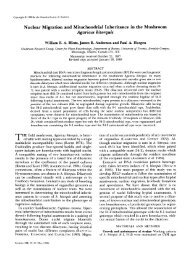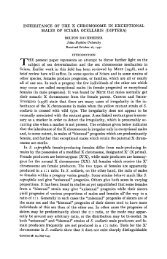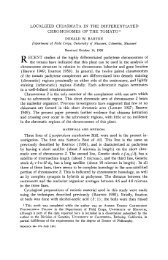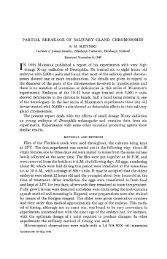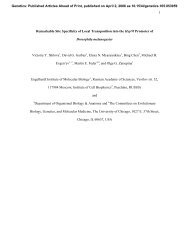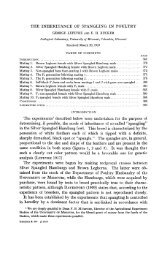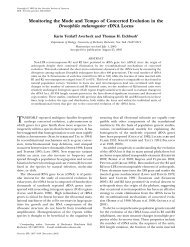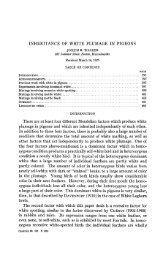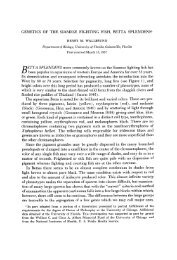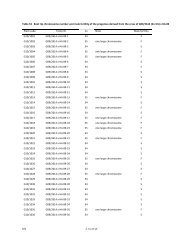abstracts of papers presented at the 1962 meetings - Genetics
abstracts of papers presented at the 1962 meetings - Genetics
abstracts of papers presented at the 1962 meetings - Genetics
Create successful ePaper yourself
Turn your PDF publications into a flip-book with our unique Google optimized e-Paper software.
ABSTRACTS 981<br />
<strong>of</strong> <strong>the</strong> mutant alleles depending upon whe<strong>the</strong>r <strong>the</strong>y are present in endosperm or seedling tissue.<br />
(This work was supported in part by grant G19395 from The N<strong>at</strong>ional Science Found<strong>at</strong>ion.)<br />
ROMAN, H., J. FRIIS, and N. R. EATON, University <strong>of</strong> Washington, Se<strong>at</strong>tle, Washington: The<br />
effect <strong>of</strong> monochrom<strong>at</strong>ic ultraviolet radi<strong>at</strong>ion on ncciprocal and nonreciprocal recombin<strong>at</strong>ion in<br />
yeast.-The wavelengths 248, 265, 280, and 313 mp have been used to tre<strong>at</strong> a diploid yeast culture<br />
in which reciprocal and nonreciprocal recombin<strong>at</strong>ion can be detected simultaneously. The<br />
diploid culture is heterozygous <strong>at</strong> an adenine locus and heteroallelic <strong>at</strong> an isoleucine locus. Reciprocal<br />
recombin<strong>at</strong>ion occurring between <strong>the</strong> centromere and <strong>the</strong> adenine locus leads to sectored<br />
red-white colonies; nonreciprocal recombin<strong>at</strong>ion <strong>at</strong> <strong>the</strong> isoleucine locus results in reversion to<br />
isoleucine independence. The shorter wavelengths are each effective in enhancing <strong>the</strong> frequency<br />
<strong>of</strong> both types <strong>of</strong> recombin<strong>at</strong>ion to a comparable degree; A313 is ineffective. The present evidence<br />
<strong>the</strong>refore does not enable us to separ<strong>at</strong>e reciprocal recombin<strong>at</strong>ion from nonreciprocal recombin<strong>at</strong>ion<br />
spectrally.<br />
RUDKIN, G. T., DAVID A. HUNGERFORD, and PETER C. NOWELL, The Institute for Cancer Research,<br />
Philadelphia, and Department <strong>of</strong> P<strong>at</strong>hology, School <strong>of</strong> Medicine, University <strong>of</strong> Pennsylvania,<br />
Philadelphia, Pa.: DNA measurements <strong>of</strong> chromosomes, including zhe Philadelphial<br />
chromosome, in human chronic granulocytic leukemia.-Human chronic granulocytic leukemia<br />
(CGL) is characterized by a deficiency within one chromosome <strong>of</strong> group 21-22, probably number<br />
21 (J. N<strong>at</strong>l. Cancer Inst. 27:1013, 1961). The present work is aimed <strong>at</strong>: (1) distinguishing<br />
between deletion and transloc<strong>at</strong>ion in this abnormal karyotype, (2) <strong>the</strong> detection <strong>of</strong> possible<br />
differences in DNA content <strong>of</strong> <strong>the</strong> deficient chromosome (<strong>the</strong> Philadelphia1 chromosome, symbol<br />
Phl) in different cases <strong>of</strong> CGL, and (3) measuring <strong>the</strong> distribution <strong>of</strong> DNA within <strong>the</strong> human<br />
karyotype. Leukocytes from peripheral blood were prepared by <strong>the</strong> method <strong>of</strong> MOORHEAD, et al.<br />
(Exptl. Cell Research 20:613, 1960) on quartz slides. Following digestion <strong>of</strong> <strong>the</strong> prepar<strong>at</strong>ions<br />
with ribonuclease, total absorbence (A,) <strong>of</strong> chromosomes <strong>at</strong> 257 mp was measured by <strong>the</strong> photographic<br />
method <strong>of</strong> CASPERSSON and SCHULTZ. Measurements have been made on one tetraploid<br />
nucleus (having two Phl chromosomes). Preliminary results show th<strong>at</strong> Phl (AT=0.093) is<br />
deficient for 4.0 percent <strong>of</strong> <strong>the</strong> DNA in a group 21-29 chromosome (AT = 0.154). Were <strong>the</strong> deficient<br />
portion <strong>of</strong> <strong>the</strong> original (normal) chromosome not lost from <strong>the</strong> nucleus, but transloc<strong>at</strong>ed to<br />
ano<strong>the</strong>r chromosome, it should be detectable by <strong>the</strong> methods employed. Since <strong>the</strong> largest chromosome<br />
in <strong>the</strong> complement (number 1) had an A, <strong>of</strong> 0.68, <strong>the</strong> transloc<strong>at</strong>ed piece (A, = 0.06)<br />
would add ten percent or more to any chromosome in <strong>the</strong> complement. Considering chromosome<br />
arms separ<strong>at</strong>ely, <strong>the</strong> minimum increase due to <strong>the</strong> transloc<strong>at</strong>ed segment would be <strong>of</strong> <strong>the</strong> order <strong>of</strong><br />
15 to 20%. Since <strong>the</strong> error <strong>of</strong> <strong>the</strong> method is less than ten percent, we expect to be able to distinguish<br />
between <strong>the</strong> altern<strong>at</strong>ives <strong>of</strong> transloc<strong>at</strong>ion and deletion in <strong>the</strong> CGL karyotype.<br />
RUSSELL, LIANE BRAUCH, JEAN W. BANGHAM, and CLYDE L. SAYLORS, Biology Division, Oak<br />
Ridge N<strong>at</strong>ional Labor<strong>at</strong>ory, Oak Ridge, Term.: Delimit<strong>at</strong>ion <strong>of</strong> chromosomal regions involved in<br />
V-type position effects from X autosome transloc<strong>at</strong>ions in <strong>the</strong> mouse.-Two new cases <strong>of</strong> V-type<br />
position effect., both involving <strong>the</strong> c locus, have been discovered. In preliminary tests, <strong>the</strong>y behave<br />
in an analogous fashion to <strong>the</strong> three reported by us earlier, and <strong>the</strong>y are <strong>the</strong>refore assumed to<br />
result from X autosome transloc<strong>at</strong>ions. One was derived from irradi<strong>at</strong>ion <strong>of</strong> sperm<strong>at</strong>ozoa; <strong>the</strong><br />
o<strong>the</strong>r was spontaneous.-Fur<strong>the</strong>r tests with <strong>the</strong> three position effects reported earlier have shown<br />
th<strong>at</strong> <strong>the</strong> autosomal regions affected are limited. Transloc<strong>at</strong>ion T(X;8), which produces b varieg<strong>at</strong>ion,<br />
has no effect on m+. The order is tent<strong>at</strong>ively assumed to be: break pokt--(7?)-W'-<br />
(6)-&(7)-m. It is doubtful whe<strong>the</strong>r varieg<strong>at</strong>ion <strong>of</strong> wi (whirler) would be detectable and<br />
none has been found to d<strong>at</strong>e. Transloc<strong>at</strong>ion T(X;l)c, originally detected by c varieg<strong>at</strong>ion,<br />
also varieg<strong>at</strong>es p+. However, while <strong>the</strong> c regions usually occupy more than half <strong>the</strong> fur, p regions<br />
are SO small and sc<strong>at</strong>tered as to be almost imperceptible. The order is assumed to be: break point-<br />
(





